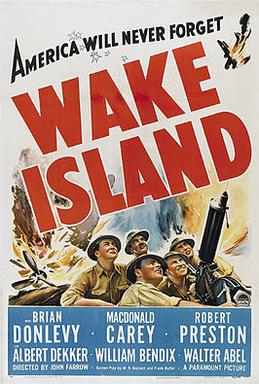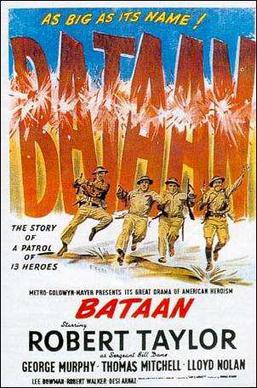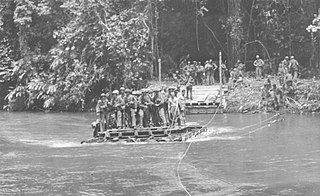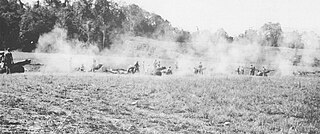
The Guadalcanal campaign, also known as the Battle of Guadalcanal and codenamed Operation Watchtower by American forces, was a military campaign fought between 7 August 1942 and 9 February 1943 on and around the island of Guadalcanal in the Pacific theater of World War II. It was the first major land offensive by Allied forces against the Empire of Japan.

Wake Island is a 1942 American action drama war film directed by John Farrow, written by W. R. Burnett and Frank Butler, and starring Brian Donlevy, Robert Preston, Macdonald Carey, Albert Dekker, Barbara Britton, and William Bendix. The film tells the story of the United States military garrison on Wake Island and the onslaught by the Japanese following the attack on Pearl Harbor.

Guadalcanal is the principal island in Guadalcanal Province of Solomon Islands, located in the southwestern Pacific Ocean, northeast of Australia. It is the largest island in the Solomons by area and the second-largest by population. The island is mainly covered in dense tropical rainforest and has a mountainous hinterland.

Richard Jaeckel was an American actor of film and television. Jaeckel became a well-known character actor in his career, which spanned six decades. He received an Academy Award nomination for Best Supporting Actor with his role in the 1971 adaptation of Ken Kesey's Sometimes a Great Notion.

Guadalcanal Diary is a memoir written by war correspondent Richard Tregaskis and originally published by Random House on January 1, 1943. The book recounts the author's time with the United States Marine Corps on Guadalcanal in the early stages of the pivotal months-long battle there starting in 1942. It was the first book published by Random House to sell more than 100,000 copies.

Bataan is a 1943 American black-and-white World War II drama film from Metro-Goldwyn-Mayer, produced by Irving Starr, and directed by Tay Garnett, that stars Robert Taylor, George Murphy, Lloyd Nolan, Thomas Mitchell, Lee Bowman, Desi Arnaz and Robert Walker. It follows the fates of a group of men charged with destroying a bridge during the doomed defense of the Bataan Peninsula by American forces in the Philippines against the invading Japanese.

The Battle of the Tenaru, sometimes called the Battle of the Ilu River or the Battle of Alligator Creek, was a land battle between the Imperial Japanese Army and Allied ground forces that took place on 21 August 1942, on the island of Guadalcanal during the Pacific campaign of World War II. The battle was the first major Japanese land offensive during the Guadalcanal campaign.

The Battle for Henderson Field, also known as the Battle of Guadalcanal or Battle of Lunga Point by the Japanese, took place from 23 to 26 October 1942 on and around Guadalcanal in the Solomon Islands. The battle was a land, sea, and air battle of the Pacific campaign of World War II and was fought between the Imperial Japanese Army and Navy and Allied forces, mainly U.S. Marines and Army. The battle was the last of three major land offensives conducted by the Japanese during the Guadalcanal campaign.

The Actions along the Matanikau—sometimes referred to as the Second and Third Battles of the Matanikau—were two separate but related engagements between the United States and Imperial Japanese naval and ground forces in the Pacific theater of World War II. The actions occurred around the Matanikau River on Guadalcanal Island in the southwestern Pacific during the Guadalcanal campaign. These particular engagements—the first taking place between 23 and 27 September, and the second between 6 and 9 October—were two of the largest and most significant of the Matanikau actions.
Akinosuke Oka was a colonel in the Imperial Japanese Army and a commander of Japanese troops during the strategically significant Guadalcanal campaign in the Pacific theater of World War II. He was posthumously promoted to major general.

Carlson's patrol, also known as The Long Patrol or Carlson's long patrol, was an operation by the 2nd Marine Raider Battalion under the command of Evans Carlson during the Guadalcanal campaign against the Imperial Japanese Army from 6 November to 4 December 1942. In the operation, the 2nd Raiders attacked forces under the command of Toshinari Shōji, which were escaping from an attempted encirclement in the Koli Point area on Guadalcanal and attempting to rejoin other Japanese army units on the opposite side of the U.S. Lunga perimeter.
Gung Ho! is a 1943 American war film directed by Ray Enright and starring Randolph Scott. The story is based somewhat on the real-life World War II Makin Island raid led by Lieutenant Colonel Evans Carlson's 2nd Marine Raider Battalion.

Frank Bryan Goettge was a United States Marine Corps intelligence officer in World War II. He led the ill-fated Goettge Patrol in the early days of the Guadalcanal campaign and was killed during that operation.

The Matanikau Offensive, from 1–4 November 1942, sometimes referred to as the Fourth Battle of the Matanikau, was an engagement between United States (U.S.) Marine and Army and Imperial Japanese Army forces around the Matanikau River and Point Cruz area on Guadalcanal during the Guadalcanal campaign of World War II. The action was one of the last of a series of engagements between U.S. and Japanese forces near the Matanikau River during the campaign.

The Kali Point action, during 3–12 November 1942, was an engagement between U.S. Marine Corps and U.S. Army forces and Imperial Japanese Army forces around Koli Point on Guadalcanal during the Guadalcanal campaign. The U.S. forces were under the overall command of Major General Alexander Vandegrift, while the Japanese forces were under the overall command of Lieutenant General Harukichi Hyakutake.

Pride of the Marines is a 1945 American biographical war film starring John Garfield and Eleanor Parker. It tells the story of U.S. Marine Al Schmid in World War II, his heroic stand against a Japanese attack during the Battle of Guadalcanal, in which he was blinded by a grenade, and his subsequent rehabilitation. The film was based on the 1944 Roger Butterfield book Al Schmid, Marine.

The Gallant Hours is a 1960 American docudrama about William F. Halsey, Jr. and his efforts in fighting against Admiral Isoroku Yamamoto and the Imperial Japanese Navy in the Guadalcanal campaign of World War II.

Marine Raiders is a 1944 RKO war film showing a fictional depiction of the 1st Marine Raider Battalion and 1st Marine Parachute Battalion on Guadalcanal, R&R in Australia, retraining in Camp Elliott and a fictional attack in the Solomon Islands. Produced by Robert Fellows, and directed by Harold D. Schuster, it stars Pat O'Brien, Robert Ryan, and Ruth Hussey.

World War II in HD is a History Channel television series that chronicles the hardships of World War II, using rare films shot in color never seen on television before. The episodes premiered on five consecutive days in mid-November 2009, with two episodes per day. The series is narrated by Gary Sinise and was produced by Lou Reda Productions in Easton, Pennsylvania.

Moon Over Burma is a 1940 American adventure film directed by Louis King and written by Harry Clork, Wilson Collison, W.P. Lipscomb and Frank Wead. The film stars Dorothy Lamour, Robert Preston, Preston Foster, Doris Nolan, Albert Bassermann, Frederick Worlock and Addison Richards. The film was released on December 11, 1940, by Paramount Pictures.


















